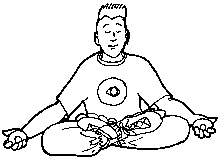I’ll be giving a lesson, working closely with a student who is making good progress. I'm beaming with pride, thinking to myself, "She’s almost got it!" I can't leave well enough alone: I love to watch what happens after I call out, “Now pretend you’re relaxed!” In an instant and without much thought her spine and arms soften and she looks like she just added on a year's worth of skating. What just happened? It’s not my powers of suggestion (don't I wish!).
Invariably when I throw this at them, my students instinctively reshape their bodies into a personal memory of what “relaxed” feels like. We both witness an immediate ease and improvement in the way they're skating. Without realizing quite how, they quit fighting their skates and become more coordinated, if only for the moment. It may be a temporary effect, but I make sure point out the change so they'll get a taste of how skating will feel in their future and get a real understanding of the benefits of letting go rather than holding on.
 To me, this represents a dramatic demonstration of the inline mind-body connection. By focusing on a more relaxed and familiar body memory, my students have reduced their physical tension and made it possible for the skates to behave.
To me, this represents a dramatic demonstration of the inline mind-body connection. By focusing on a more relaxed and familiar body memory, my students have reduced their physical tension and made it possible for the skates to behave.
Relax and Allow
New skaters start out with jerky movements because they are holding tight to a large number of muscles in the attempt to maintain control. Fear and bodily tension hinder the mobility and balanced postures that will one day bring fluid movement. It takes time and experience (and instruction) to eventually grow the right muscle memories that result in 1) better balance and 2) greater confidence so they are 3) able to relax and 4) skate more efficiently.
Of course, you want to look good on skates as soon as possible, right? Your first priority is to start practicing a wide variety of skating moves to build up your mobility and agility. You also need to know what "relaxed" feels like in your own body, so you can deliberately call it up at will. Sound hard? Visit my Mind-Body Connection section for lessons that will help you learn to breathe properly, reduce stress through meditation, and gain kinesthetic and emotional self-awareness that can lead to optimal fitness and performance. And be sure to read a related article in this edition of the Orbit, Holistic Approach to Skating Success.
Quality time on skates will eventually lead to letting the skates do their job rather than trying to make them perform. There is a certain Zen quality to this concept.
Grace and Speed
Sustained aerobic-level skating typically results in a natural high from endorphins, a delightful chemical manufactured in the human body. Besides enjoying the optimism and happiness it brings, if you also focus on harnessing the creativity of this mental state, you stand to gain significant technique breakthroughs.
Pay attention to the rhythm of your movements as you repeatedly stride and glide. Visualize a centerline in the path ahead and find new ways to smooth out anything that wastes energy or deflects you from a straight-ahead flow along that line. Play around with your favorite stride improvement drills. Breathe.
As you begin to feel tired, employ your creative endorphin high to devise ways to “work smarter, not harder.” Check your posture to make sure your weight remains stacked over your heels, the power-generating part of your skates.
Pretend you’re relaxed! Let your skates do their job!